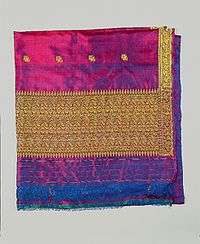Sari
A sari, saree or sharee[note 1] is a women's garment from the Indian subcontinent[1] that consists of an unstitched drape varying from 4.5 to 9 metres (15 to 30 feet) in length[2] and 600 to 1,200 millimetres (24 to 47 inches) in breadth[3] that is typically wrapped around the waist, with one end draped over the shoulder, covering a larger portion of the midriff.[4][5][6] There are various styles of sari manufacture and draping, the most common being the Nivi style, which originated in the Deccan region.[7][8] The sari is worn with a fitted bodice commonly called a choli (ravike in southern India, and cholo in Nepal) and a petticoat called ghagra, parkar or ul-pavadai.[9] In the modern Indian subcontinent, the sari is considered a cultural icon.[10]

Etymology
The word sari described in Sanskrit शाटी śāṭī[11] which means 'strip of cloth'[12] and शाडी śāḍī or साडी sāḍī in Pali, and which evolved to sāṛī in modern Indian languages.[13] The word 'Sattika' is mentioned as describing women's attire in ancient India in Sanskrit literature and Buddhist literature called Jatakas.[14] This could be equivalent to modern day 'Sari'.[14] The term for female bodice, the choli evolved from ancient Stanapatta.[15][16] Rajatarangini, a tenth-century literary work by Kalhana, states that the choli from the Deccan was introduced under the royal order in Kashmir.[9]
The petticoat is called parkar (परकर) in Marathi, ulpavadai (உள்பாவாடை) in Tamil (pavada in other parts of South India: Malayalam: പാവാട, Telugu: పావడ, romanized: pāvāḍai, Kannada: ಪಾವುಡೆ, romanized: pāvuḍe) and shaya (সায়া) in Bengali and eastern India. Apart from the standard "petticoat", it may also be called "inner skirt"[17] or an inskirt.
Origins and history
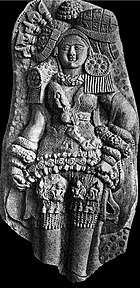
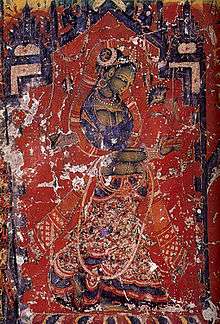

History of sari-like drapery is traced back to the Indus Valley Civilisation, which flourished during 2800–1800 BCE around the northwestern part of the Indian subcontinent.[4][5][6] Cotton was first cultivated and woven in Indian subcontinent around 5th millennium BCE.[18] Dyes used during this period are still in use, particularly indigo, lac, red madder and turmeric.[19] Silk was woven around 2450 BCE and 2000 BCE.[20][21]
The word 'sari' evolved from 'saatikaa' (Sanskrit: शाटिका) mentioned in earliest Hindu literature as women's attire.[22][14] The Sari or Sattika evolved from a three-piece ensemble comprising the Antriya, the lower garment; the Uttariya; a veil worn over the shoulder or the head; and the Stanapatta, a chestband. This ensemble is mentioned in Sanskrit literature and Buddhist Pali literature during the 6th century BCE.[23] This complete three-piece dress was known as Poshak, generic term for costume.[24] Ancient Antriya closely resembled dothi wrap in the "fishtail" version which was passed through legs, covered the legs loosely and then flowed into a long, decorative pleats at front of the legs.[4][25][26] It further evolved into Bhairnivasani skirt, today known as ghagri and lehenga.[27] Uttariya was a shawl-like veil worn over the shoulder or head, it evolved into what is known today known as dupatta and ghoonghat.[28] Likewise, Stanapatta evolved into choli by 1st century CE.[15][16][29][30]
The ancient Sanskrit work, Kadambari by Banabhatta and ancient Tamil poetry, such as the Silappadhikaram, describes women in exquisite drapery or sari.[9][31][32][33] In ancient India, although women wore saris that bared the midriff, the Dharmasastra writers stated that women should be dressed such that the navel would never become visible.[34][35] By which for some time the navel exposure became a taboo and the navel was concealed.[5][36][37] In ancient Indian tradition and the Natya Shastra (an ancient Indian treatise describing ancient dance and costumes), the navel of the Supreme Being is considered to be the source of life and creativity, hence the midriff is to be left bare by the sari.[38][39]
It is generally accepted that wrapped sari-like garments for lower body and sometimes shawls or scarf like garment called 'uttariya' for upper body, have been worn by Indian women for a long time, and that they have been worn in their current form for hundreds of years. In ancient couture the lower garment was called 'nivi' or 'nivi bandha', while the upper body was mostly left bare.[14] The works of Kalidasa mentions 'Kurpasika' a form of tight fitting breast band that simply covered the breasts.[14] It was also sometimes referred to as 'Uttarasanga' or 'Stanapatta'.[14]
Poetic references from works like Silappadikaram indicate that during the Sangam period in ancient Tamil Nadu in southern India, a single piece of clothing served as both lower garment and head covering, leaving the midriff completely uncovered.[31] Similar styles of the sari are recorded paintings by Raja Ravi Varma in Kerala.[40] Numerous sources say that everyday costume in ancient India and till recent times in Kerala consisted of a pleated dhoti or (sarong) wrap, combined with a breast band called 'Kurpasika' or 'Stanapatta' and occasionally a wrap called 'Uttariya' that could at times be used to cover the upper body or head.[14] The two-piece Kerala mundum neryathum (mundu, a dhoti or sarong, neryath, a shawl, in Malayalam) is a survival of ancient clothing styles. The one-piece sari in Kerala is derived from neighboring Tamil Nadu or Deccan during medieval period based on its appearance on various temple murals in medieval Kerala.[41][5][6][42]
Early Sanskrit literature has a wide vocabulary of terms for the veiling used by women, such as Avagunthana (oguntheti/oguṇthikā), meaning cloak-veil, Uttariya meaning shoulder-veil, Mukha-pata meaning face-veil and Sirovas-tra meaning head-veil.[43] In the Pratimānātaka, a play by Bhāsa describes in context of Avagunthana veil that "ladies may be seen without any blame (for the parties concerned) in a religious session, in marriage festivities, during a calamity and in a forest".[43] The same sentiment is more generically expressed in later Sanskrit literature.[44] Śūdraka, the author of Mṛcchakatika set in fifth century BCE says that the Avagaunthaha was not used by women everyday and at every time. He says that a married lady was expected to put on a veil while moving in the public.[44] This may indicate that it was not necessary for unmarried females to put on a veil.[44] This form of veiling by married women is still prevalent in Hindi-speaking areas, and is known as ghoonghat where the loose end of a sari is pulled over the head to act as a facial veil.[45]
Based on sculptures and paintings, tight bodices or cholis are believed have evolved between 2nd century BCE to 6th century CE in various regional styles.[46][46] Early cholis were front covering tied at the back; this style was more common in parts of ancient northern India. This ancient form of bodice or choli are still common in the state of Rajasthan today.[47] Varies styles of decorative traditional embroidery like gota patti, mochi, pakko, kharak, suf, kathi, phulkari and gamthi are done on cholis.[48] In Southern parts of India, choli is known as ravikie which is tied at the front instead of back, kasuti is traditional form of embroidery used for cholis in this region.[49] In Nepal, choli is known as cholo or chaubandi cholo and is traditionally tied at the front.[50]
Red is most favored colour for wedding saris and are traditional garment choice for brides in Indian culture.[51] Women traditionally wore various types of regional handloom saris made of silk, cotton, ikkat, block-print, embroidery and tie-dye textiles. Most sought after brocade silk saris are Banasari, Kanchipuram, Gadwal, Paithani, Mysore, Uppada, Bagalpuri, Balchuri, Maheshwari, Chanderi, Mekhela, Ghicha, Narayan pet and Eri etc. are traditionally worn for festive and formal occasions.[52] Silk Ikat and cotton saris known as Patola, Pochampally, Bomkai, Khandua, Sambalpuri, Gadwal, Berhampuri, Bargarh, Jamdani, Tant, Mangalagiri, Guntur, Narayan pet, Chanderi, Maheshwari, Nuapatn, Tussar, Ilkal, Kotpad and Manipuri were worn for both festive and everyday attire.[53] Tie-dyed and block-print saris known as Bandhani, Leheria/Leheriya, Bagru, Ajrakh, Sungudi, Kota Dabu/Dabu print, Bagh and Kalamkari were traditionally worn during monsoon season.[54] Gota Patti is popular form of traditional embroidery used on saris for formal occasions, various other types of traditional folk embroidery such mochi, pakko, kharak, suf, kathi, phulkari and gamthi are also commonly used for both informal and formal occasion.[55][56] Today, modern fabrics like polyester, georgette and charmeuse are also commonly used.[57][58][59]
Styles of draping
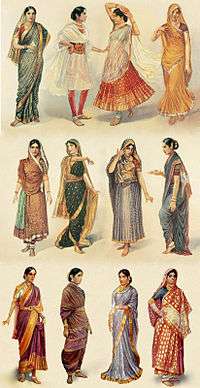
There are more than 80 recorded ways to wear a sari.[60] The most common style is for the sari to be wrapped around the waist, with the loose end of the drape to be worn over the shoulder, baring the midriff.[61] However, the sari can be draped in several different styles, though some styles do require a sari of a particular length or form. Ṛta Kapur Chishti, a Sari historian and recognised textile scholar, has documented 108 ways of wearing a Sari in her book, ‘Saris: Tradition and Beyond’. The book documents the sari drapes across fourteen states of Gujarat, Maharashtra, Goa, Karnataka, Kerala, Tamil Nadu, Andhra Pradesh, Odisha, West Bengal, Jharkhand, Bihar, Chhattisgarh, Madhya Pradesh, and Uttar Pradesh.[62] The French cultural anthropologist and sari researcher Chantal Boulanger categorised sari drapes in the following families:[5]
- Nivi sari – styles originally worn in Deccan region; besides the modern nivi, there is also the kaccha nivi, where the pleats are passed through the legs and tucked into the waist at the back. This allows free movement while covering the legs.
- Bengali and Odia style is worn without any pleats.[63] Traditionally the Bengali style is worn without pleats where the sari is wrapped around in an anti-clockwise direction around the waist and then a second time from the other direction. The loose end is a lot longer and that goes around the body over the left shoulder. There is enough cloth left to cover the head as well. The modern style of wearing a sari originates from the Tagore family. Jnanadanandini Devi, the wife of Rabindranath Tagore's elder brother Satyendranath came up with a different way to wear the sari after her stay in Bombay. This required a chemise or jacket (old name for blouse) and petticoat to be worn under the sari and made it possible for women to come out of the secluded women's quarters (purdah) in this attire.
- Gujarati/Rajasthani – after tucking in the pleats similar to the nivi style, the loose end is taken from the back, draped across the right shoulder, and pulled across to be secured in the back
- Himalayan - Kulluvi Pattu is traditional form of woolen sari worn in Himachal Pradesh, similar variation is also worn in Uttarakhand.
- Nepali: Nepal has many different varieties of draping sari, today the most common is the Nivi drape. The Bhojpuri and Awadhi speaking community wears the sari sedha pallu like the Gujrati drape. The Mithila community has its own traditional Maithili drapes like the madhubani and purniea drapes but today those are rare and most sari is worn with the pallu in the front or the nivi style.[64] The women of the Rajbanshi communities traditionally wear their sari with no choli and tied below the neck like a towel but today only old women where it in that style and the nivi and the Bengali drapes are more popular today. The traditional Newari sari drape is, folding the sari till its below knee length and then wearing it like a nivi sari but the pallu is not worn across the chest and instead is tied around the wait and leaving it so it drops from wait to the knee, instead the pallu a shawl is tied across the chest, by wrapping it from the right hip and back and is thrown over the shoulders saris are worn with blouse that are thicker and are tied several times across the front.The Nivi drape was popularized in Nepal by the Shah royals and the Ranas.
- Nauvari: this drape is very similar to that of the male Maharashtrian dhoti, though there are many regional and societal variations. The centre of the sari (held lengthwise) is placed at the centre back, the ends are brought forward and tied securely, then the two ends are wrapped around the legs. When worn as a sari, an extra-long cloth of nine yards is used and the ends are then passed up over the shoulders and the upper body. This style of draping is called as "Navvari Sari" (Kashta in Konkani). Women in villages of Maharashtra still drape their saris in this manner. The style worn by Brahmin women of differs from that of the Marathas. The style also differs from community to community. This style is popular in Maharashtra and Goa. Nowadays this style has become very famous through Indian cinema and is trending in Maharashtrian weddings.
- Madisar – this drape is typical of Iyengar/Iyer Brahmin ladies from Tamil Nadu. Traditional Madisar is worn using 9 yards sari.[65]
- Pin Kosuvam - this is the traditional Tamil Nadu style
- Kodagu style – this drape is confined to ladies hailing from the Kodagu district of Karnataka. In this style, the pleats are created in the rear, instead of the front. The loose end of the sari is draped back-to-front over the right shoulder, and is pinned to the rest of the sari.
- Gobbe Seere – This style is worn by women in the Malnad or Sahyadri and central region of Karnataka. It is worn with 18 molas sari with three-four rounds at the waist and a knot after crisscrossing over shoulders.
- Assamese – This sari style is three-set garment known Mekhela chador. The bottom portion, draped from the waist downwards is called Mekhela and veil is known as Chadar and is worn with long sleeve choli.
- Manipuri - This sari style is also worn with three-set garment known as Innaphi viel, Phanek lower wrap and long sleeved choli.
- Khasi - Khasi style of sari is known as Jainsem which is made up of several pieces of cloth, giving the body a cylindrical shape.
- Malayali style – the two-piece sari, or Mundum Neryathum, worn in Kerala. Usually made of unbleached cotton and decorated with gold or coloured stripes and/or borders. Also the Kerala sari, a sort of mundum neryathum.
- Tribal styles – often secured by tying them firmly across the chest, covering the breasts.
- Kunbi style or denthli:Goan Gauda and Kunbis, and those of them who have migrated to other states use this way of draping Sari or Kappad, this form of draping is created by tying a knot in the fabric below the shoulder and a strip of cloth which crossed the left shoulder was fasten on the back.[66]
Historic photographs and regional styles
 Women in choli (blouse) and antariya CE 320 Gupta Empire.
Women in choli (blouse) and antariya CE 320 Gupta Empire. Kalpasutra manuscript c. 1375 CE.
Kalpasutra manuscript c. 1375 CE. Green Tara depicted with sari, c. 11th century CE.
Green Tara depicted with sari, c. 11th century CE. Girl in Gujarati sari; in this style, the loose end is worn on the front.
Girl in Gujarati sari; in this style, the loose end is worn on the front.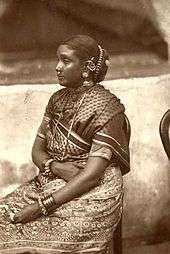 Woman in Tamil sari; in this style, the loose end is wrapped around the waist.
Woman in Tamil sari; in this style, the loose end is wrapped around the waist. Girl in Bengali sari; in this style sari is worn without any pleats.
Girl in Bengali sari; in this style sari is worn without any pleats. Kandyan Sinhalese lady wearing a traditional Kandyan sari (osaria).
Kandyan Sinhalese lady wearing a traditional Kandyan sari (osaria). Girl in pochampally sari, 1895 CE.
Girl in pochampally sari, 1895 CE.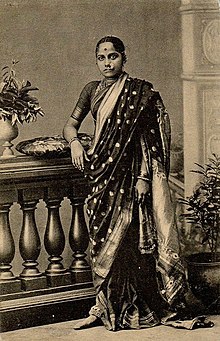 Women in nauvari sari.
Women in nauvari sari. Women in Mysore sari.
Women in Mysore sari. Women in sari 1912.
Women in sari 1912. Girl in nauvari sari a form of kachha nivi worn in Maharashtra.
Girl in nauvari sari a form of kachha nivi worn in Maharashtra. Woman in nivi sari & vaddanam.
Woman in nivi sari & vaddanam.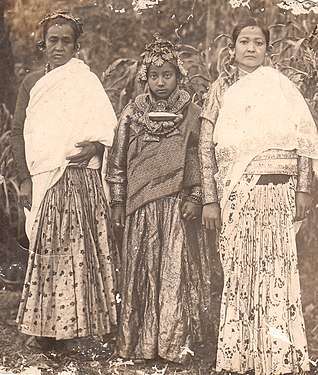 Newar bride and two women in sari, 1941.
Newar bride and two women in sari, 1941.
Nivi style

The Nivi drape was borne out of necessity to pander to Victorian sensibilities and is a vestige of the colonial past. Jnanadanandini Devi, sister-in-law of Rabindranath Tagore, crafted the Nivi drape and borrowed the blouse and petticoat as a means of fitting into a British dominated social structure while maintaining an Indian identity.[67][68] The British attempted to formalize the complex Indian culture by fitting it into well-defined stereotypes. The sari did not fit into the ethos of the Victorian era, which prioritized modesty over freedom of movement. The British could not accept the fluidity of Indian culture and felt the need to impose their singular world-view through political and cultural hegemony.[69]
The nivi is today's most popular sari style from Deccan region.[7][8] The increased interaction with the British saw most women from royal families come out of purdah in the 1900s. This necessitated a change of dress. Maharani Indira Devi of Cooch Behar popularised the chiffon sari. She was widowed early in life and followed the convention of abandoning her richly woven Baroda shalus in favour of the unadorned mourning white as per tradition. Characteristically, she transformed her "mourning" clothes into high fashion. She had saris woven in France to her personal specifications, in white chiffon, and introduced the silk chiffon sari to the royal fashion repertoire.[70]
The chiffon sari did what years of fashion interaction had not done in India. It homogenised fashion across this land. Its softness, lightness and beautiful, elegant, caressing drape was ideally suited to the Indian climate. Different courts adopted their own styles of draping and indigenising the sari. In most of the courts the sari was embellished with stitching hand-woven borders in gold from Varanasi, delicate zardozi work, gota, makaish and tilla work that embellished the plain fabric, simultaneously satisfying both traditional demands and ingrained love for ornamentation. Some images of maharanis in the Deccan show the women wearing a sleeveless, richly embellished waistcoat over their blouses. The Begum of Savanur remembers how sumptuous the chiffon sari became at their gatherings. At some courts, it was worn with jaali, or net kurtas and embossed silk waist length sadris or jackets. Some of them were so rich that the entire ground was embroidered over with pearls and zardozi.[70][71]
Nivi drape starts with one end of the sari tucked into the waistband of the petticoat, usually a plain skirt. The cloth is wrapped around the lower body once, then hand-gathered into even pleats below the navel. The pleats are tucked into the waistband of the petticoat.[72] They create a graceful, decorative effect which poets have likened to the petals of a flower.[72] After one more turn around the waist, the loose end is draped over the shoulder.[72] The loose end is called the pallu, pallav, seragu, or paita depending on the language. It is draped diagonally in front of the torso. It is worn across the right hip to over the left shoulder, partly baring the midriff.[72] The navel can be revealed or concealed by the wearer by adjusting the pallu, depending on the social setting. The long end of the pallu hanging from the back of the shoulder is often intricately decorated. The pallu may be hanging freely, tucked in at the waist, used to cover the head, or used to cover the neck, by draping it across the right shoulder as well. Some nivi styles are worn with the pallu draped from the back towards the front, coming from the back over the right shoulder with one corner tucked by the left hip, covering the torso/waist. The nivi sari was popularised through the paintings of Raja Ravi Varma.[40] In one of his paintings, the Indian subcontinent was shown as a mother wearing a flowing nivi sari.[40] The ornaments generally accepted by the Hindu culture that can be worn in the midriff region are the waist chains. They are considered to be a part of bridal jewellery.[73][74]
Professional style of draping

Because of the harsh extremes in temperature on the Indian Subcontinent, the sari fills a practical role as well as a decorative one. It is not only warming in winter and cooling in summer, but its loose-fitting tailoring is preferred by women who must be free to move as their duties require. For this reason, it is the Air India uniform for air hostesses.[75][76] An air hostess style sari is draped in similar manner to a traditional sari, but most of the pleats are pinned to keep them in place.[77]
Saris are worn as uniforms by the female hotel staff of many five-star luxury hotels in India as the symbol of Indian culture.[78] Similarly, the female politicians of India wear the sari in a professional manner. The women of Nehru–Gandhi family like Indira Gandhi and Sonia Gandhi wear the special blouse for the campaign trail which is longer than usual and is tucked in to prevent any midriff show while waving to the crowds. Stylist Prasad Bidapa has to say, "I think Sonia Gandhi is the country's most stylish politician. But that's because she's inherited the best collection of saris from her mother-in-law. I'm also happy that she supports the Indian handloom industry with her selection." BJP politician Sushma Swaraj maintains her prim housewife look with a pinned-up pallu while general secretary of AIADMK Jayalalithaa wears her saris like a suit of armour.[79]
Bangladesh
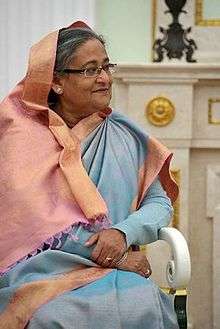
Sharee (Bengali: শাড়ি) is the national wear of Bangladeshi women. Most women who are married wear sharee as their regular dress while young-unmarried girls wear sharee as an occasional dress. The sharee is worn by women throughout Bangladesh. Sharee is the most popular dress for women in Bangladesh, both for casual and formal occasion. Although Dhakai Jamdani (hand made sharee) is worldwide known and most famous to all women who wear sharee but there are also many variety of sharees in Bangladesh. There are many regional variations of them in both silk and cotton. e.g.- Tanta/Tant cotton sharee, Dhakai Banarasi sari, Rajshahi silk, Tangail Sari, Tant sari, Tassar silk sharee, Manipuri sharee and Katan sharee are the most popular in Bangladesh. It is the uniform of the air hostesses of Biman Bangladesh Airlines.
Sri Lanka
.jpg)
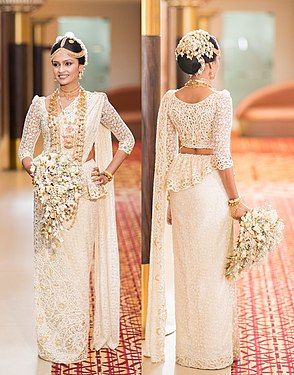
Sri Lankan women wear saris in many styles. Two ways of draping the sari are popular and tend to dominate: the Indian style (classic nivi drape) and the Kandyan style (or osaria in Sinhala). The Kandyan style is generally more popular in the hill country region of Kandy from which the style gets its name. Though local preferences play a role, most women decide on style depending on personal preference or what is perceived to be most flattering for their figure.
The traditional Kandyan (osaria) style consists of a full blouse which covers the midriff completely and is partially tucked in at the front. However, the modern intermingling of styles has led to most wearers baring the midriff. The final tail of the sari is neatly pleated rather than free-flowing. This is rather similar to the pleated rosette used in the Dravidian style noted earlier in the article.
The Kandyan style is considered the national dress of Sinhalese women. It is the uniform of the air hostesses of SriLankan Airlines.
During the 1960s, the mini sari known as 'hipster' sari created a wrinkle in Sri Lankan fashion, since it was worn below the navel and barely above the line of prosecution for indecent exposure. The conservative people described the 'hipster' as "an absolute travesty of a beautiful costume almost a desecration" and "a hideous and purposeless garment".[80][81]
Nepal
The sari is the most commonly worn women's clothing in Nepal where a special style of sari draping is called haku patasihh. The sari is draped around the waist and a shawl is worn covering the upper half of the sari, which is used in place of a pallu.
Pakistan
In Pakistan, the saris are still popular and worn on special occasions. The Shalwar kameez, however, is worn throughout the country on a daily basis. The sari nevertheless remains a popular garment among the middle and upper class for many formal functions. Saris can be seen worn commonly in metropolitan cities such as Karachi and Islamabad and are worn regularly for weddings and other business types of functions. Saris are also worn by many Muslim women in Sindh to show their status or to enhance their beauty. [82] The sari is worn as daily wear by Pakistani Hindus, by elderly Muslim women who were used to wearing it in pre-partition India[83] and by some of the new generation who have reintroduced the interest in saris by wearing saree with traditional Muslim head wrap called hijab in many beautiful ways.[84]
Similarities with other Asian clothing
While the sari is typical to traditional wear for women in the Indian subcontinent, clothing worn by women in Southeast Asian countries like Myanmar, Malaysia, the Philippines, Cambodia, Thailand and Laos resemble it, where a long rectangular piece of cloth is draped around the body. These are different from the sari as they are wrapped around the lower-half of body as a skirt, worn with a shirt/blouse and resemble a sarong, as seen in the Burmese Longyi, Filipino Malong and Tapis, Laotian Xout lao and Suea pat, Thai Sbai and Sinh, Cambodian Sampot and Timorese Tais. Saris, worn predominantly in the Indian subcontinent are usually draped with one end of the cloth fastened around the waist, and the other end placed over the shoulder baring the midriff.[4][5][6]
Ornamentation and decorative accessories

Saris are woven with one plain end (the end that is concealed inside the wrap), two long decorative borders running the length of the sari, and a one to three-foot section at the other end which continues and elaborates the length-wise decoration. This end is called the pallu; it is the part thrown over the shoulder in the nivi style of draping.
In past times, saris were woven of silk or cotton. The rich could afford finely woven, diaphanous silk saris that, according to folklore, could be passed through a finger ring. The poor wore coarsely woven cotton saris. All saris were handwoven and represented a considerable investment of time or money.
Simple hand-woven villagers' saris are often decorated with checks or stripes woven into the cloth. Inexpensive saris were also decorated with block printing using carved wooden blocks and vegetable dyes, or tie-dyeing, known in India as bhandani work.
More expensive saris had elaborate geometric, floral, or figurative ornaments or brocades created on the loom, as part of the fabric. Sometimes warp and weft threads were tie-dyed and then woven, creating ikat patterns. Sometimes threads of different colours were woven into the base fabric in patterns; an ornamented border, an elaborate pallu, and often, small repeated accents in the cloth itself. These accents are called buttis or bhuttis (spellings vary). For fancy saris, these patterns could be woven with gold or silver thread, which is called zari work.

Sometimes the saris were further decorated, after weaving, with various sorts of embroidery. Resham work is embroidery done with coloured silk thread. Zardozi embroidery uses gold and silver thread, and sometimes pearls and precious stones. Cheap modern versions of zardozi use synthetic metallic thread and imitation stones, such as fake pearls and Swarovski crystals.
In modern times, saris are increasingly woven on mechanical looms and made of artificial fibres, such as polyester, nylon, or rayon, which do not require starching or ironing. They are printed by machine, or woven in simple patterns made with floats across the back of the sari. This can create an elaborate appearance on the front, while looking ugly on the back. The punchra work is imitated with inexpensive machine-made tassel trim. Fashion designer Aaditya Sharma declared, "I can drape a sari in 54 different styles".[85]
Hand-woven, hand-decorated saris are naturally much more expensive than the machine imitations. While the overall market for handweaving has plummeted (leading to much distress among Indian handweavers), hand-woven saris are still popular for weddings and other grand social occasions.
Sari outside the Indian subcontinent

The traditional sari made an impact in the United States during the 1970s. Eugene Novack who ran the New York store, Royal Saree House told that he had been selling it mainly to the Indian women in New York area but later many American business women and housewives became his customers who preferred their saris to resemble the full gown of the western world. He also said that men appeared intrigued by the fragility and the femininity it confers on the wearer.[86] Newcomers to the sari report that it is comfortable to wear, requiring no girdles or stockings and that the flowing garb feels so feminine with unusual grace.[87][88]
The sari has gained its popularity internationally because of the growth of Indian fashion trends globally. Many Bollywood celebrities, like Aishwarya Rai,[89][90] have worn it at international events representing the Indian culture. In 2010, Bollywood actress Deepika Padukone wanted to represent her country at an international event, wearing the national costume. On her very first red carpet appearance at the Cannes International Film Festival, she stepped out on the red carpet in a Rohit Bal sari.[91][92]
International celebrities have worn traditional sari attire designed by Indian fashion designers.[93] Pamela Anderson made a surprise guest appearance on Bigg Boss, the Indian version of Big Brother, dressed in a sari that was specially designed for her by Mumbai-based fashion designer Ashley Rebello.[94] Ashley Judd donned a purple sari at the YouthAIDS Benefit Gala in November 2007 at the Ritz Carlton in Mclean, Virginia.[95][96][97] There was an Indian flavour to the red carpet at the annual Fashion Rocks concert in New York, with designer Rocky S walking the ramp along with Jessica, Ashley, Nicole, Kimberly and Melody – the Pussycat Dolls – dressed in saris.[98] in 2014, American singer Selena Gomez was seen in a sari for an UNICEF charity event at Nepal.[99]
In the United States, the sari has recently became politicised with the digital-movement, "Sari, Not Sorry". Tanya Rawal-Jindia, a gender studies professor at University of California, Riverside, initiated this anti-xenophobia fashion-campaign on Instagram.[100][101][102][103]
Types
While an international image of the modern style sari may have been popularised by airline flight attendants, each region in the Indian subcontinent has developed, over the centuries, its own unique sari style. Following are other well-known varieties, distinct on the basis of fabric, weaving style, or motif, in the Indian subcontinent:
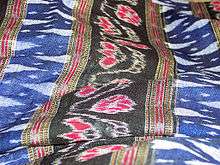
Central styles
- Chanderi sari[104] – Madhya Pradesh
- Maheshwari – Maheshwar, Madhya Pradesh
- Kosa silk – Chhattisgarh
- Dhokra silk – Madhya Pradesh
Eastern styles
- Taant sari – throughout Bengal
- Baluchari Sari – Bishnupur, West Bengal
- Kaantha sari – throughout Bengal
- Garode / Korial – Murshidabad, West Bengal
- Shantipuri cotton – Shantipur, Phulia, West Bengal
- Jamdani / Dhakai – Dhaka, Bangladesh
- Rajshahi silk / Eri – Rajshahi, Bangladesh
- Dhakai Katan – Dhaka, Bangladesh
- Mooga silk – Assam
- Mekhla Cotton – Assam
- Sambalpuri Silk & Cotton sari – Sambalpur, Odisha
- Ikkat Silk & Cotton sari – Bargarh, Odisha
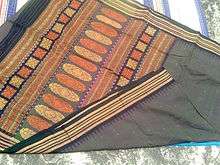
- Bomkai Silk & Cotton Sari – Bomkai, Ganjam, Odisha
- Khandua Silk & Cotton sari – Nuapatna, Cuttack, Odisha
- Pasapali Sari – Bargarh, Odisha
- Sonepuri Silk & Cotton sari – Subarnapur, Odisha
- Berhampuri silk – Behrampur, Odisha
- Mattha Silk sari – Mayurbhanj, Odisha
- Bapta Silk & Cotton sari – Koraput, Odisha
- Kotpad Pata sari – Koraput, Odisha
- Tanta Cotton sari – Balasore, Odisha
- Manipuri Tant sari – Manipur
- Moirang Phi sari – Manipur
- Patt Silk sari – Assam
- Kotki sari – Orissa
- Kotpad sari – Orissa
Western styles
- paithanpattu - maharashtra
- yeola sari - maharashtra
- peshwai shalu - maharashtra
- mahalsa sari - maharashtra
- narayanpeth - maharashtra
- khun fabric - mharashtra
- karvati tussar sari - maharashtra
Southern styles

- Mysore silk – Karnataka
- Kanchipuram Silk (locally called Kanjipuram pattu) – Tamil Nadu
- Arani silk - Tamil Nadu
- Ilkal sari – Karnataka
- Molakalmuru Sari – Karnataka
- Sulebhavi sari – Sulebhavi, Karnataka
- Venkatagiri – Andhra Pradesh
- Mangalagiri Silk saris – Andhra Pradesh
- Uppada Silk saris – Andhra Pradesh
- Chirala saris – Andhra Pradesh
- Bandar saris – Andhra Pradesh
- Bandarulanka – Andhra Pradesh
- Kuppadam saris – Andhra Pradesh
- Dharmavaram silk sari – Andhra Pradesh
- Chettinad saris – Tamil Nadu
- Kumbakonam – Tamil Nadu
- Thirubuvanam – Tamil Nadu
- Coimbatore cotton – Tamil Nadu
- Salem silk – Tamil Nadu
- Chinnalampattu or Sungudi – Tamil Nadu
- Kandangi – Tamil Nadu
- Rasipuram silk saris – Tamil Nadu
- Koorai – Tamil Nadu
- Arni silk sari – Tamil Nadu
- Chennai – Tamil Nadu
- Karaikudi – Tamil Nadu
- Madurai cotton saris – Tamil Nadu
- Tiruchirappalli saris – Tamil Nadu
- Nagercoil saris – Tamil Nadu
- Thoothukudi – Tamil Nadu
- Thanjavur saris – Tamil Nadu
- Tiruppur – Tamil Nadu
- Kerala sari silk and cotton – Kerala
- Balarampuram – Kerala
- Mundum Neriyathum – Kerala
- Mayilati silk – Kerala
- Kannur cotton – Kerala
- Kalpathi silk saris – Kerala
- Maradaka silk – Kerala
- Samudrikapuram silk and cotton – Kerala
- Kasargod – Kerala
%2C_silk_and_gold-wrapped_silk_yarn_with_supplementary_weft_brocade.jpg)
- Pochampally Sari or Puttapaka sari – Telangana[105]
- Gadwal sari – Telangana
- Narayanpet – Telangana
Northern styles
- Banarasi – Uttar Pradesh
- Shalu – Uttar Pradesh
- Tanchoi – Uttar Pradesh
Images
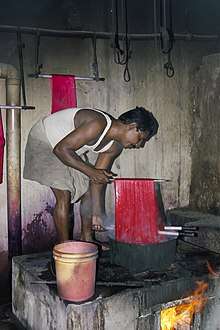 A man dyeing a silk sari red in boiling water in Kumbakonam, Tamil Nadu
A man dyeing a silk sari red in boiling water in Kumbakonam, Tamil Nadu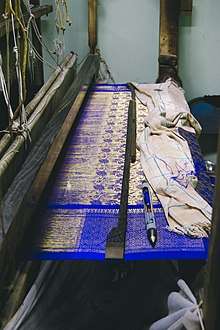 A silk sari loom in Kumbakonam, Tamil Nadu
A silk sari loom in Kumbakonam, Tamil Nadu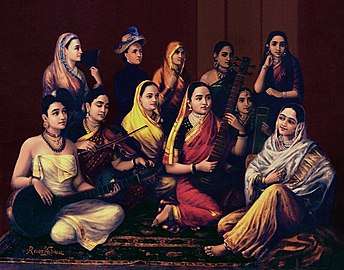 Galaxy of Musicians by Raja Ravi Varma depicting women in various styles of sari.
Galaxy of Musicians by Raja Ravi Varma depicting women in various styles of sari. Silk weaving at Kanchipuram, Tamil Nadu
Silk weaving at Kanchipuram, Tamil Nadu Wooden printing-blocks used for block-print saris.
Wooden printing-blocks used for block-print saris..jpg) Dyed silk yarns for sari.
Dyed silk yarns for sari. Handloom Kanchivaram silk sari.
Handloom Kanchivaram silk sari. Handloom in Varanasi, Uttar Pradesh.
Handloom in Varanasi, Uttar Pradesh. Handloom in Varanasi
Handloom in Varanasi.jpg) Weaving at work in Kanchipuram
Weaving at work in Kanchipuram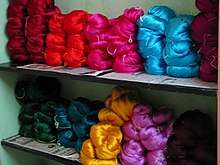 Dyed silk yarns for weaving saris.
Dyed silk yarns for weaving saris.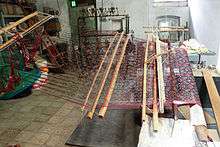 Double-Ikat handloom for Patola sari in Gujarat.
Double-Ikat handloom for Patola sari in Gujarat. Weaving Jamdani sari in handloom, Bangladesh.
Weaving Jamdani sari in handloom, Bangladesh. Weavers at work in Bangladesh.
Weavers at work in Bangladesh..jpg) Child wearing sari in Bangladesh.
Child wearing sari in Bangladesh.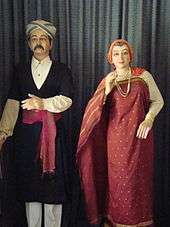 Style of sari worn in Coorg.
Style of sari worn in Coorg..jpg) handloom weaver at work.
handloom weaver at work.- Devadasis from Goa.
-1.jpg) Sinhalese woman wearing a traditional Kandyan sari (osaria).
Sinhalese woman wearing a traditional Kandyan sari (osaria)..jpg) Weaving saris in Kancipuram.
Weaving saris in Kancipuram..jpg) Display of handloom saris.
Display of handloom saris..jpg) Bangladeshi bridal handloom sari.
Bangladeshi bridal handloom sari.
See also
- Ghagra choli
- Indian dress
- Indian wedding clothes
- Lehenga-style sari
- Salwar kameez
- Saree cancer
Notes
- The name of the garment in various regional languages include:
Bengali: শাড়ি śāṛi, Hindi: साड़ी sāṛī (AST), Odia: ଶାଢୀ, sāddhi, Gujarati: સાડી, sāḍī, Kannada: ಸೀರೆ, sīrē, Konkani: साडी, कापड, चीरे, sāḍī, kāpaḍ, cīrē, Malayalam: സാരി sāri, Marathi: साडी sāḍī, Nepali: सारी sārī, Punjabi: ਸਾਰੀ sārī, Tamil: புடவை puṭavai, Telugu: చీర cīra, Urdu: ساڑى sāṛī
References
- Lynton, Linda (1995). The Sari. New York: Harry N. Abrams, Incorporated. ISBN 978-0-8109-4461-9.
- Boulanger, Chantal (1997). Saris: An Illustrated Guide to the Indian Art of Draping. New York: Shakti Press International. ISBN 978-0-9661496-1-6.
- Boulanger, Chantal (1997). Saris: An Illustrated Guide to the Indian Art of Draping. New York: Shakti Press International. p. 6.
- Alkazi, Roshan (1983) "Ancient Indian costume", Art Heritage
- Boulanger, Chantal; (1997) Saris: An Illustrated Guide to the Indian Art of Draping, Shakti Press International, New York.
- Ghurye (1951) "Indian costume", Popular book depot (Bombay); (Includes rare photographs of 19th century Namboothiri and nair women in ancient saree with bare upper torso)
- Boulanger, Chantal (1997). Saris: an illustrated guide to the Indian art of draping. Shakti Press International. p. 55.
Women of Andhra Pradesh claim that the modern sari is their own traditional drape . . . this claim is probably true.
- Linda Lynton(1995), The Sari: Styles, Patterns, History, Technique ISBN 978-0-8109-4461-9, page 187; Quote: It is in the Karnataka (Mysore) and western Maharashtran area that the nivi style is believed to have originated..
- Katiyar, Vijai Singh (2009). Indian saris : traditions, perspectives, design. New Delhi: Wisdom Tree in association with National Institute of Design, Ahmedabad. p. 211. ISBN 9788183281225. Retrieved 31 October 2015.
- "Sari, Always in Vogue". Hinduism Today. Retrieved 9 March 2018.
- R. S. McGregor, ed. (1997). The Oxford Hindi-English Dictionary. Oxford University Press. p. 1003. ISBN 978-0-19-864339-5.
- Monier-Williams, Monier (1995). A Sanskrit-English Dictionary. Delhi: Motilal Banarsidass. p. 1063. ISBN 978-81-208-0065-6. Retrieved 4 July 2010.
- Kapoor, Subodh (2002). The Indian encyclopaedia: biographical, historical, religious, administrative, ethnological, commercial and scientific. Reunion-Satya Yauvana, Volume 20. Genesis Publishing Pvt Ltd. p. 6422 (pg no. starts from 6130). ISBN 978-81-7755-257-7.
The etymology of the word sari is from the Sanskrit 'sati', which means strip of cloth. This evolved into the Prakriti 'sadi', and was later anglicised into sari
- Sachidanand, Sahay (1975) Indian costume, coiffure, and ornament. Chapter 2 'Female Dress', Munshiram Manoharlal publishers Pvt Ltd. pp 31–55
- Prachya Pratibha, 1978 "Prachya Pratibha, Volume 6", p.121
- Agam Kala Prakashan, 1991 "Costume, coiffure, and ornaments in the temple sculpture of northern Andhra", p.118
- "How to wear saree perfectly - Glowpink". 26 March 2015. Archived from the original on 20 November 2015.
- Stein, Burton (1998). A History of India. Blackwell Publishing. ISBN 0-631-20546-2, p. 47
- "What did the Indus people wear and what material were their clothes made of?". Harappa.com. Retrieved 26 December 2015.
- Abbott, Phill (19 February 2009). "Rethinking silk's origins : Nature News". Nature. 457 (7232): 945. doi:10.1038/457945a. PMID 19238684.
- Good, I.L.; Kenoyer, J.M.; Meadow, R.H. (2009). "New evidence for early silk in the Indus civilization" (PDF). Archaeometry. 50 (3): 457. doi:10.1111/j.1475-4754.2008.00454.x.
- Mohapatra, R. P. (1992) "Fashion styles of ancient India", B. R. Publishing corporation, ISBN 81-7018-723-0
- Prasad Mohapatra, Ramesh (1992). Fashion Styles of Ancient India: A Study of Kalinga from Earliest Times to Sixteenth Century Ad. B.R. Publishing Corporation. p. 35. ISBN 9788170187233.
- Bhandari, Vandana (2005). Costume, textiles and jewellery of India: traditions in Rajasthan. Mercury Books. p. 84. ISBN 9780811810845.
- Linda Lynton (1995) "The Sari: Styles, Patterns, History, Techniques.", p.170
- Prof. Dipak Sharma (2012) "SOUVENIR of 2nd International Science Congress (ISC-2012).", p.282
- J. Correia-Afonso, (1984) "Indica, Volume 21, Issue 2", p.126
- Chintaman Vinayak Vaidya, (2001) "Epic India : India as Described in the Mahabharata and the Ramayana", p.144
- Roshen Alkazi, 1996 "Ancient Indian Costume", p.48
- Levick, Melba; Crites, Mitchell; Nanji, Ameeta (2008). IndiaColor: Spirit, Tradition, and Style. Chronicle Books. p. 47. ISBN 978-0-8118-5316-3.
- Parthasarathy, R. (1993). The Tale of an Anklet: An Epic of South India – The Cilappatikaram of Ilanko Atikal, Translations from the Asian Classics. New York: Columbia Univ. Press. ISBN 978-0-231-07849-8.
- Emma Tarlo (1996) "Clothing Matters: Dress and Identity in India.", p.154
- Govind Sadashiv Ghurye (1951) "Indian Costume.", p.154
- Encyclopedia of Indian Women Through the Ages: Ancient India – Simmi Jain.
- Anant Sadashiv Altekar (1956). The Position of Women in Hindu Civilization, From Prehistoric Times to the Present Day. Motilal Banarsidass Publ. p. 380. ISBN 9788120803244.
- Sumner, William Graham (1 September 2007). Folkways: A Study of Mores, Manners, Customs and Morals. Cosimo, Inc. ISBN 9781602067585. Retrieved 13 January 2017 – via Google Books.
- Linda Lynton, Sanjay K. Singh (2002) "The Sari: Styles, Patterns, History, Techniques.", p.40
- Bharata (1967). The Natyashastra [Dramaturgy], 2 vols., 2nd. ed. Trans. by Manomohan Ghosh. Calcutta: Manisha Granthalaya
- Beck, Brenda (1976). "The Symbolic Merger of Body, Space, and Cosmos in Hindu Tamil Nadu". Contributions to Indian Sociology. 10 (2): 213–243. doi:10.1177/006996677601000202.
- Miller, Daniel & Banerjee, Mukulika, The Sari (2004), Lustre press / Roli books.
- Wall paintings in North Kerala, India: 1000 years of temple art, Albrecht Frenz, Ke. Ke Mārār, page 93
- Miller, Daniel & Banerjee, Mukulika; (2004) "The Sari", Lustre press / Roli books
- Govind Sadashiv Ghurye (1951) "Indian Costume.", p.236
- Sulochana Ayyar (1987) "Costumes and Ornaments as Depicted in the Sculptures of Gwalior Museum.", p.152
- Kusumanjali Prakashan, 1993 "The Natyasastra tradition and ancient Indian society", p.63
- Katiyar, Vijay Singh. (2009). INDIAN SARIS – Traditions – Perspective – Design. New Delhi, Ahmedabad – INDIA: Wisdom Tree in association with NATIONAL INSTITUTE OF DESIGN. p. 24. ISBN 978-81-8328-122-5.
- Chander, Prakash (2003). India: past & present - Prakash Chander – Google Books. ISBN 9788176484558. Retrieved 13 November 2011.
- Victoria and Albert Museum, Rosemary Crill (1999). Indian embroidery Fashion. V&A Publications. p. 93. ISBN 9781851773107.
- History of Kasuti is mentioned by Govind D. Belgaumkar and Anil Kumar Sastry (27 October 2006). "Unique symbols of Karnataka". Online Edition of The Hindu, dated 2006-10-27. Chennai, India: 2006, The Hindu. Retrieved 22 April 2007.
- Indra Majupuria (2007) "Nepalese Women: A Vivid Account of the Status and Role of Nepalese Women in the Total Spectrum of Life, Religious, Social, Economic, Political, and Legal.", p.291
- Ava Laboy Capo (2013) "Wedding Traditions from Around the World.", p.18
- "Saree saga: Draped for elegance, growth too". The Economic Times. Mumbai. 5 April 2009.
- Jay Narayan Vyas, Textile Review, 2007 "Indian Textiles 2015: Comprehensive Forecast on Indian Textiles Industry in 2015 with an Exhaustive Buyer's Guide for Textile Machinery", p.126
- Wada, Yoshiko Iwamoto (2002). Memory on Cloth: Shibori Now. Kodansha International. p. 28. ISBN 9784770027771.
- "Embroidery on Indian wedding wear | Gota work". Marrymeweddings.in. 24 November 2011. Retrieved 1 January 2014.
- Anne Morrell (1995) "The Techniques of Indian Embroidery.", p.68
- "Indian Bridal Wear Trends 2014, Photos & Review". Vivah Planners. Archived from the original on 14 July 2014. Retrieved 4 July 2014.
At times, even use of different fabrics like crêpe, Georgette, tissue and satin are used.
- Sandhu, Arti (2015). Indian Fashion: Tradition, Innovation, Style. bloomsbury. p. 19. ISBN 978-18478-8780-1.
- Rocca, Federico (2009). Contemporary Indian Fashion. Damiani. p. 136. ISBN 9788862081009.
- Anita Rao Kashi. "How to Wear a Sari in India". World Hum. Retrieved 18 March 2012.
- "The History of Indian Sarees - Hatena Blog". nidhishekhawat.hatenablog.com. Retrieved 20 March 2020.
- Chishti, R̥ta Kapur; Singh, Martand (2010). Saris of India: Tradition and Beyond. Roli Books, Lustre Press. ISBN 9788174363749.
- "Regional Styles of Wearing A Sari By Indian Women".
- "Nivi Style Saree Draping". Indian Wedding Saree. 10 April 2018. Retrieved 16 January 2019.
- "Madisar Pudavai". Tamilnadu.com. 5 February 2013.
- Sikka, Raghav. "Wendell Rodricks showcase". Hindustan Times. New Delhi. Retrieved 25 December 2015.
- "Dressing the Indian woman". 6 December 2014. Retrieved 17 March 2019.
- "9 Facts You Might Not Know About The Sari". Google Arts & Culture. Retrieved 17 March 2019.
- Gupta, Toolika (2011). "The Effect of British Raj on Indian Costume" (PDF). Process Arts.
- Kumar, Rita (May 2008). "A story of sartorial amalgamation". Seminar (585). Archived from the original on 14 September 2008.
- "Royal style diaries for the princess in you". theluxecafe.com. Retrieved 13 January 2017.
- Dongerkerry, Kamala, S. (1959) The Indian sari. New Delhi.
- Communications, Emmis (June 2004). Indianapolis Monthly – Jun 2004. Retrieved 13 November 2011.
- "18 Traditional Saree Draping Styles From Different Parts Of India". The Ethnic Soul. 25 January 2017. Retrieved 30 October 2018.
- "Air India". 15 June 2011.
- Sarah Murray (15 March 2005). "How haute couture went on to even greater heights". Financial Times. p. 4.
The nationality of the airline company is often also reflected in the designs of the cabin crew uniforms, such as ... the saris of Air India.
- "Handy tips to wear a saree 'Air-hostess' style!". Sareez.wordpress.com. 20 February 2011. Retrieved 13 November 2011.
- "Now Banarasi sarees for Taj staff". Rediff.com. Retrieved 13 November 2011.
- Akanksha Swarup & Soni Sangwan (20 April 2009). "Sari secrets of politicians!". India Today. Archived from the original on 24 October 2011. Retrieved 20 March 2012.
- "Minisaree causes uproar in Ceylon". Gadsden Times. 11 July 1969. Retrieved 13 March 2012.
- "Eastern Miniskirt causes considerable uproar". Reading Eagle. 6 July 1969. Retrieved 13 March 2012.
- "Bollywood, saris and a bombed train". Asia Times. Retrieved 31 August 2007.
- "The spread of the salwar". The Hindu. Chennai, India. 24 October 2004. Retrieved 31 August 2007.
- "The Ultimate Guide to How to Wear Hijab With Saree Right". All Things Hijab. 24 May 2020. Retrieved 24 June 2020.
- Davina Raisinghani (12 January 2009). "Sari, it's a wrap". Khaleej Times Online. Retrieved 20 March 2012.
- "Sari is coming trend in USA". The Hour. 4 January 1977. Retrieved 20 March 2012.
- Helen Hennessy (20 April 1965). "Indian Sari is Exotic Style". The Leader-Post. Retrieved 20 March 2012.
- Helen Hennessy (22 April 1965). "Stylish Set Only Six Yards Away From Sari Fashions". Eugene Register-Guard. Retrieved 20 March 2012.
- ""Ravan's star-studded premiere in London," The Indian Express". The Indian Express. India. 17 June 2010. Retrieved 13 November 2011.
- "Indian threads: When Bollywood celebrities went ethnic at Cannes". Th Indian Express. Retrieved 4 June 2016.
- ""Deepika walks Cannes red carpet in saree," The Hindu". The Hindu. India. Press Trust of India. 14 May 2010. Retrieved 13 November 2011.
- "Deepika always wanted to wear saree at international do". Movies.ndtv.com. Archived from the original on 4 May 2012. Retrieved 13 November 2011.
- "Saree – Re-emerging as the Fashion Icon of Indian Youth!". forimmediaterelease.net. Retrieved 7 February 2015.
- Bhushan, Nyay (19 November 2010). ""Pamela Anderson Gets Indian Makeover for TV Turn," The Hollywood Reporter". The Hollywood Reporter. Retrieved 13 November 2011.
- "Firang babes in saree-Ashley Judd". The Times of India. Archived from the original on 24 December 2010. Retrieved 13 November 2011.
- "Around the world in 9 yards". Hindustan Times. India. Archived from the original on 26 December 2011. Retrieved 13 November 2011.
- "Ashley Judd Is So Very Sari". TMZ. 28 May 2007. Retrieved 13 November 2011.
- "Saree jahan se achha, The Times of India". The Times of India. 12 September 2008. Retrieved 13 November 2011.
- "Spotted: Selena Gomez shows off her sexy curves in a sari". India Today. 24 May 2014. Retrieved 4 June 2016.
- "Twitter Campaign #SareeNotSorry Fights Xenophobia". Bustle. Retrieved 1 August 2019.
- pbordelon@theadvocate.com, PAM BORDELON |. "'Saree Not Sorry' campaign aims to break down cultural walls". The Advocate. Retrieved 1 August 2019.
- "The #SareeNotSorry Movement Is Taking a Beautiful Stand Against Xenophobia". Mic. Retrieved 1 August 2019.
- West, REENA RATHORE, India. "Professor Tanya Rawal's #SareeNotSorry Campaign Uses Fashion to Fight Racism". India West. Retrieved 1 August 2019.
- "History of Chanderi sarees". Bunkar Virasat Sanrkshan Sanstha [Weaver Heritage Conservancy]. Albira. Archived from the original on 25 September 2011.
- GI registration: Pochampally sarees set the trend, The Hindu, 28 December 2005.
Bibliography
- Ambrose, Kay (1950) Classical Dances and Costumes of India. London: A. & C. Black.
- Craddock, Norma (1994) Anthills, Split Mothers, and Sacrifice: Conceptions of Female Power in the Mariyamman Tradition. Dissertation, University of California, Berkeley.
External links
| Wikimedia Commons has media related to Saris. |
